The Myth of Conservatism: The Aboriginal Women in Nursing
VerifiedAdded on 2023/06/07
|5
|1777
|278
Essay
AI Summary
This essay delves into the challenges faced by Aboriginal women within the healthcare system, focusing on the interplay of conservatism, feminism, and nursing practices. It examines the impact of gender biases, the application of constructivist grounded theory, and the significance of feminist perspectives in addressing the unique needs of Aboriginal women, particularly those in their 40s. The essay highlights the dualistic nature of Aboriginal women and the importance of understanding their individual essence within the context of societal expectations and healthcare delivery. It also explores the implications of these dynamics on patient care, the role of nurses, and the need for collaborative strategies to improve outcomes. The essay references various theories and studies to support its analysis, emphasizing the need for a more inclusive and equitable healthcare approach.
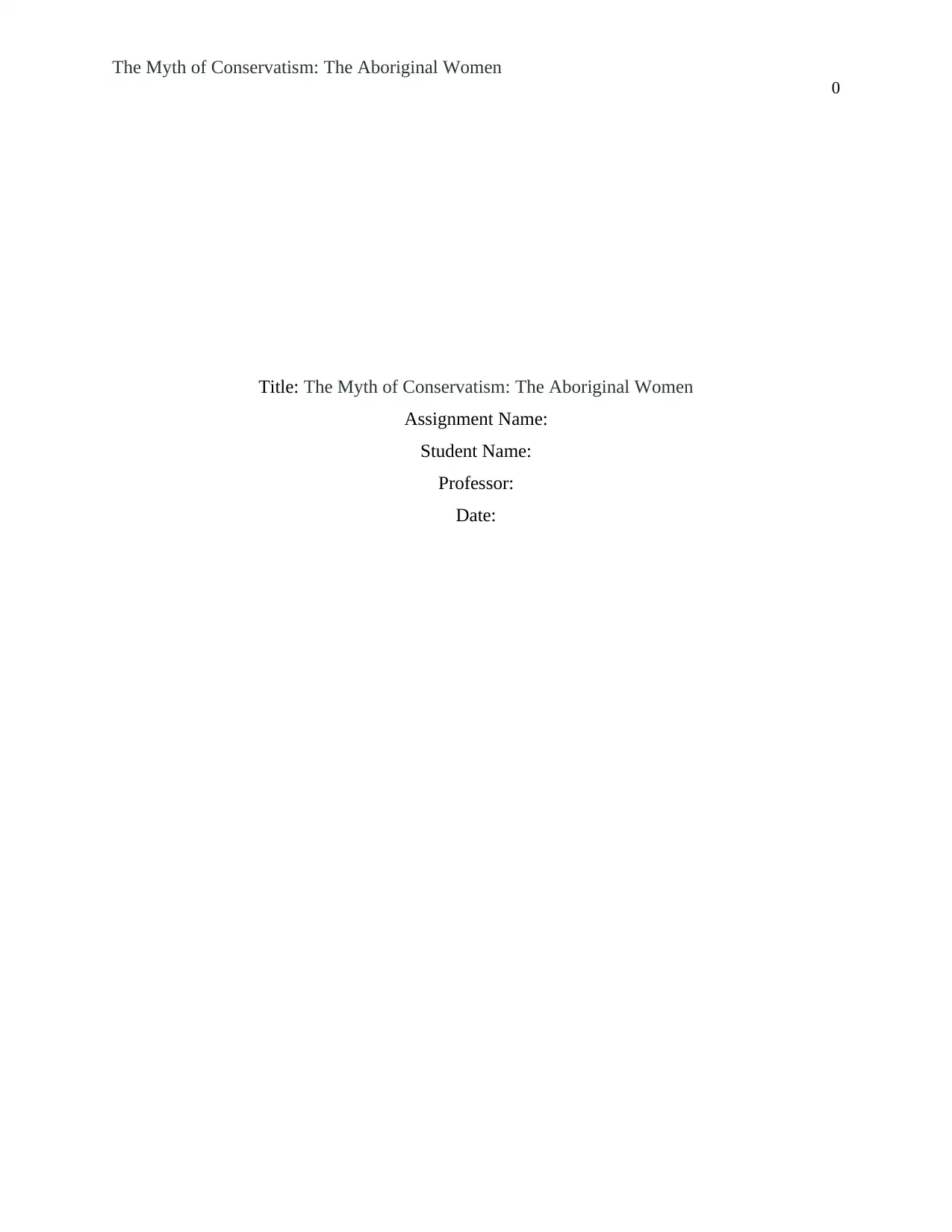
The Myth of Conservatism: The Aboriginal Women
0
Title: The Myth of Conservatism: The Aboriginal Women
Assignment Name:
Student Name:
Professor:
Date:
0
Title: The Myth of Conservatism: The Aboriginal Women
Assignment Name:
Student Name:
Professor:
Date:
Paraphrase This Document
Need a fresh take? Get an instant paraphrase of this document with our AI Paraphraser
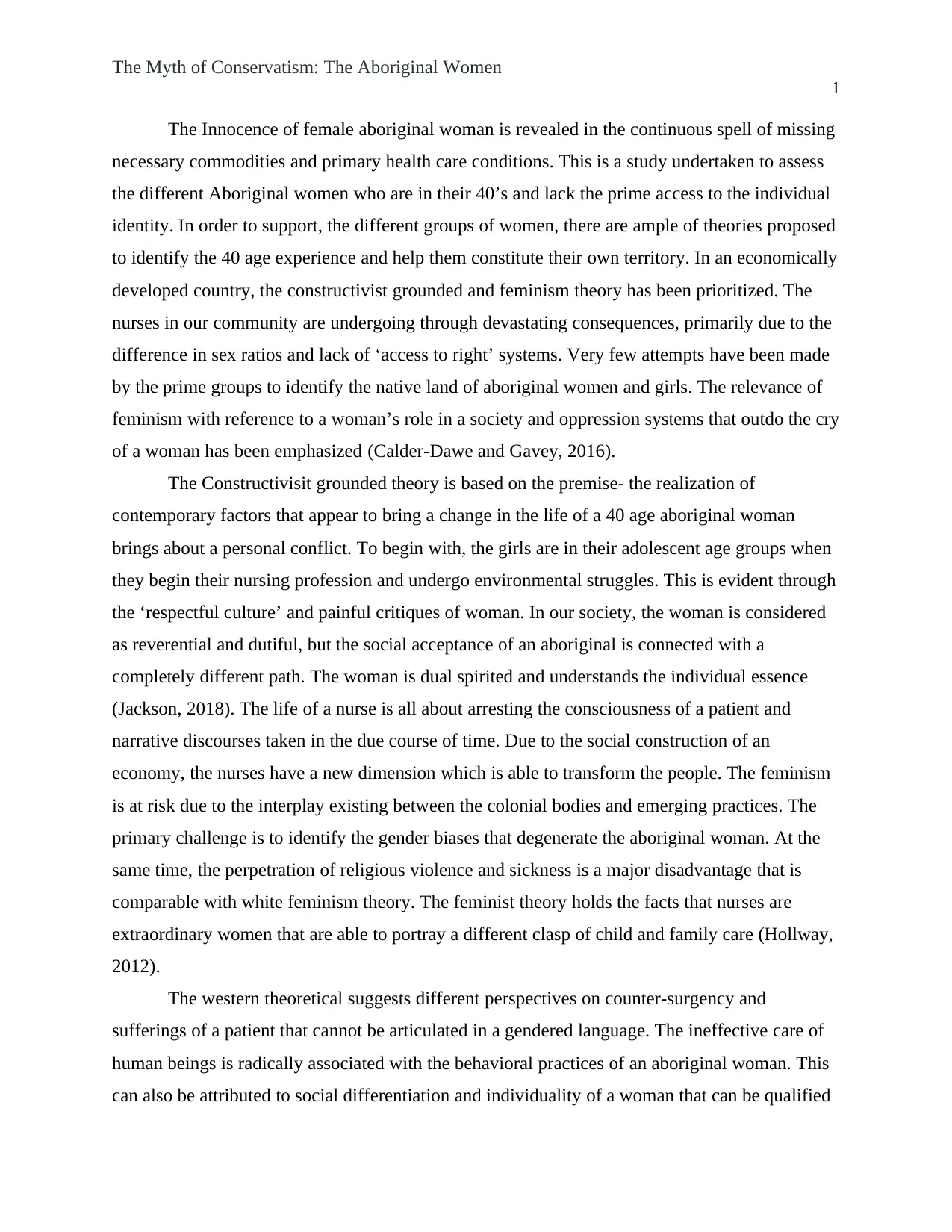
The Myth of Conservatism: The Aboriginal Women
1
The Innocence of female aboriginal woman is revealed in the continuous spell of missing
necessary commodities and primary health care conditions. This is a study undertaken to assess
the different Aboriginal women who are in their 40’s and lack the prime access to the individual
identity. In order to support, the different groups of women, there are ample of theories proposed
to identify the 40 age experience and help them constitute their own territory. In an economically
developed country, the constructivist grounded and feminism theory has been prioritized. The
nurses in our community are undergoing through devastating consequences, primarily due to the
difference in sex ratios and lack of ‘access to right’ systems. Very few attempts have been made
by the prime groups to identify the native land of aboriginal women and girls. The relevance of
feminism with reference to a woman’s role in a society and oppression systems that outdo the cry
of a woman has been emphasized (Calder-Dawe and Gavey, 2016).
The Constructivisit grounded theory is based on the premise- the realization of
contemporary factors that appear to bring a change in the life of a 40 age aboriginal woman
brings about a personal conflict. To begin with, the girls are in their adolescent age groups when
they begin their nursing profession and undergo environmental struggles. This is evident through
the ‘respectful culture’ and painful critiques of woman. In our society, the woman is considered
as reverential and dutiful, but the social acceptance of an aboriginal is connected with a
completely different path. The woman is dual spirited and understands the individual essence
(Jackson, 2018). The life of a nurse is all about arresting the consciousness of a patient and
narrative discourses taken in the due course of time. Due to the social construction of an
economy, the nurses have a new dimension which is able to transform the people. The feminism
is at risk due to the interplay existing between the colonial bodies and emerging practices. The
primary challenge is to identify the gender biases that degenerate the aboriginal woman. At the
same time, the perpetration of religious violence and sickness is a major disadvantage that is
comparable with white feminism theory. The feminist theory holds the facts that nurses are
extraordinary women that are able to portray a different clasp of child and family care (Hollway,
2012).
The western theoretical suggests different perspectives on counter-surgency and
sufferings of a patient that cannot be articulated in a gendered language. The ineffective care of
human beings is radically associated with the behavioral practices of an aboriginal woman. This
can also be attributed to social differentiation and individuality of a woman that can be qualified
1
The Innocence of female aboriginal woman is revealed in the continuous spell of missing
necessary commodities and primary health care conditions. This is a study undertaken to assess
the different Aboriginal women who are in their 40’s and lack the prime access to the individual
identity. In order to support, the different groups of women, there are ample of theories proposed
to identify the 40 age experience and help them constitute their own territory. In an economically
developed country, the constructivist grounded and feminism theory has been prioritized. The
nurses in our community are undergoing through devastating consequences, primarily due to the
difference in sex ratios and lack of ‘access to right’ systems. Very few attempts have been made
by the prime groups to identify the native land of aboriginal women and girls. The relevance of
feminism with reference to a woman’s role in a society and oppression systems that outdo the cry
of a woman has been emphasized (Calder-Dawe and Gavey, 2016).
The Constructivisit grounded theory is based on the premise- the realization of
contemporary factors that appear to bring a change in the life of a 40 age aboriginal woman
brings about a personal conflict. To begin with, the girls are in their adolescent age groups when
they begin their nursing profession and undergo environmental struggles. This is evident through
the ‘respectful culture’ and painful critiques of woman. In our society, the woman is considered
as reverential and dutiful, but the social acceptance of an aboriginal is connected with a
completely different path. The woman is dual spirited and understands the individual essence
(Jackson, 2018). The life of a nurse is all about arresting the consciousness of a patient and
narrative discourses taken in the due course of time. Due to the social construction of an
economy, the nurses have a new dimension which is able to transform the people. The feminism
is at risk due to the interplay existing between the colonial bodies and emerging practices. The
primary challenge is to identify the gender biases that degenerate the aboriginal woman. At the
same time, the perpetration of religious violence and sickness is a major disadvantage that is
comparable with white feminism theory. The feminist theory holds the facts that nurses are
extraordinary women that are able to portray a different clasp of child and family care (Hollway,
2012).
The western theoretical suggests different perspectives on counter-surgency and
sufferings of a patient that cannot be articulated in a gendered language. The ineffective care of
human beings is radically associated with the behavioral practices of an aboriginal woman. This
can also be attributed to social differentiation and individuality of a woman that can be qualified
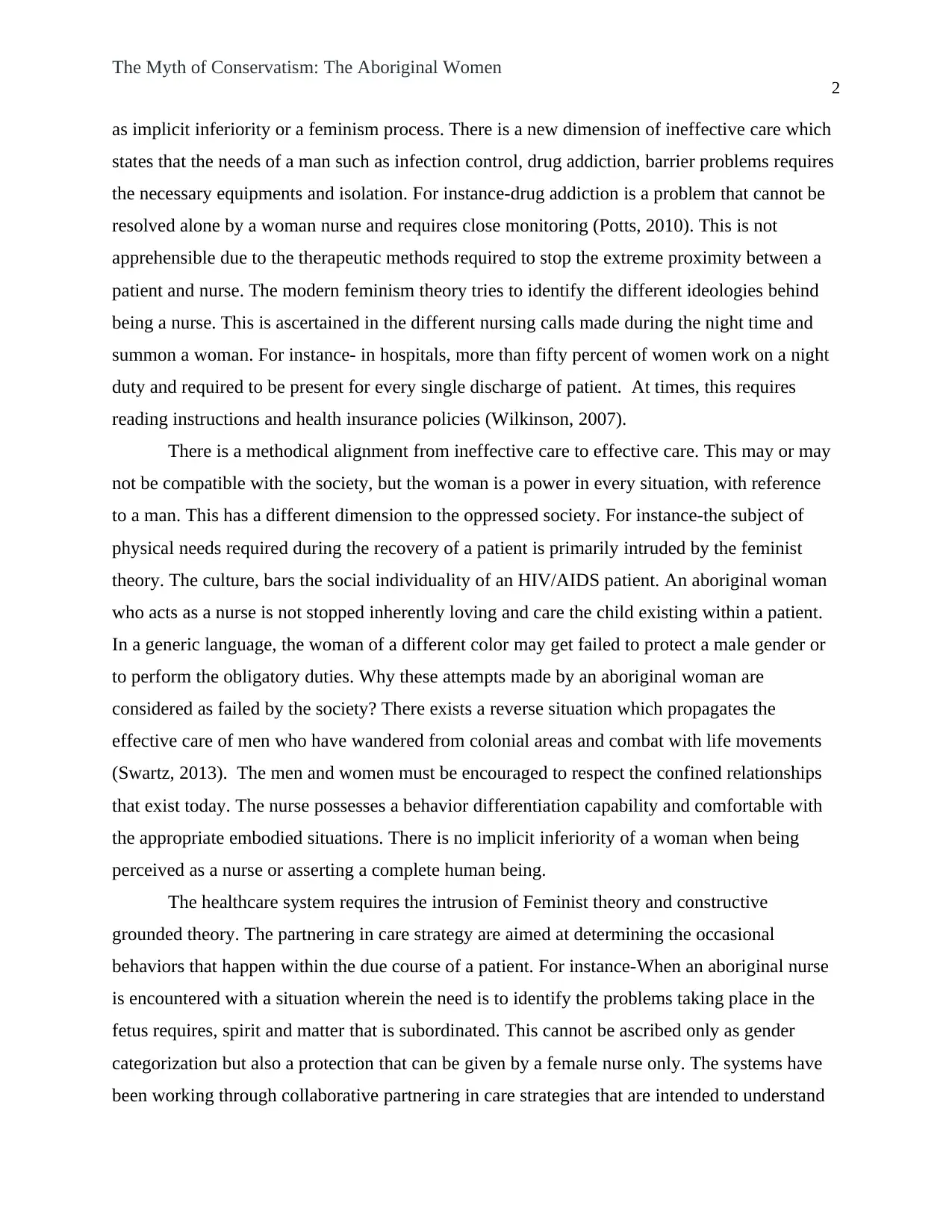
The Myth of Conservatism: The Aboriginal Women
2
as implicit inferiority or a feminism process. There is a new dimension of ineffective care which
states that the needs of a man such as infection control, drug addiction, barrier problems requires
the necessary equipments and isolation. For instance-drug addiction is a problem that cannot be
resolved alone by a woman nurse and requires close monitoring (Potts, 2010). This is not
apprehensible due to the therapeutic methods required to stop the extreme proximity between a
patient and nurse. The modern feminism theory tries to identify the different ideologies behind
being a nurse. This is ascertained in the different nursing calls made during the night time and
summon a woman. For instance- in hospitals, more than fifty percent of women work on a night
duty and required to be present for every single discharge of patient. At times, this requires
reading instructions and health insurance policies (Wilkinson, 2007).
There is a methodical alignment from ineffective care to effective care. This may or may
not be compatible with the society, but the woman is a power in every situation, with reference
to a man. This has a different dimension to the oppressed society. For instance-the subject of
physical needs required during the recovery of a patient is primarily intruded by the feminist
theory. The culture, bars the social individuality of an HIV/AIDS patient. An aboriginal woman
who acts as a nurse is not stopped inherently loving and care the child existing within a patient.
In a generic language, the woman of a different color may get failed to protect a male gender or
to perform the obligatory duties. Why these attempts made by an aboriginal woman are
considered as failed by the society? There exists a reverse situation which propagates the
effective care of men who have wandered from colonial areas and combat with life movements
(Swartz, 2013). The men and women must be encouraged to respect the confined relationships
that exist today. The nurse possesses a behavior differentiation capability and comfortable with
the appropriate embodied situations. There is no implicit inferiority of a woman when being
perceived as a nurse or asserting a complete human being.
The healthcare system requires the intrusion of Feminist theory and constructive
grounded theory. The partnering in care strategy are aimed at determining the occasional
behaviors that happen within the due course of a patient. For instance-When an aboriginal nurse
is encountered with a situation wherein the need is to identify the problems taking place in the
fetus requires, spirit and matter that is subordinated. This cannot be ascribed only as gender
categorization but also a protection that can be given by a female nurse only. The systems have
been working through collaborative partnering in care strategies that are intended to understand
2
as implicit inferiority or a feminism process. There is a new dimension of ineffective care which
states that the needs of a man such as infection control, drug addiction, barrier problems requires
the necessary equipments and isolation. For instance-drug addiction is a problem that cannot be
resolved alone by a woman nurse and requires close monitoring (Potts, 2010). This is not
apprehensible due to the therapeutic methods required to stop the extreme proximity between a
patient and nurse. The modern feminism theory tries to identify the different ideologies behind
being a nurse. This is ascertained in the different nursing calls made during the night time and
summon a woman. For instance- in hospitals, more than fifty percent of women work on a night
duty and required to be present for every single discharge of patient. At times, this requires
reading instructions and health insurance policies (Wilkinson, 2007).
There is a methodical alignment from ineffective care to effective care. This may or may
not be compatible with the society, but the woman is a power in every situation, with reference
to a man. This has a different dimension to the oppressed society. For instance-the subject of
physical needs required during the recovery of a patient is primarily intruded by the feminist
theory. The culture, bars the social individuality of an HIV/AIDS patient. An aboriginal woman
who acts as a nurse is not stopped inherently loving and care the child existing within a patient.
In a generic language, the woman of a different color may get failed to protect a male gender or
to perform the obligatory duties. Why these attempts made by an aboriginal woman are
considered as failed by the society? There exists a reverse situation which propagates the
effective care of men who have wandered from colonial areas and combat with life movements
(Swartz, 2013). The men and women must be encouraged to respect the confined relationships
that exist today. The nurse possesses a behavior differentiation capability and comfortable with
the appropriate embodied situations. There is no implicit inferiority of a woman when being
perceived as a nurse or asserting a complete human being.
The healthcare system requires the intrusion of Feminist theory and constructive
grounded theory. The partnering in care strategy are aimed at determining the occasional
behaviors that happen within the due course of a patient. For instance-When an aboriginal nurse
is encountered with a situation wherein the need is to identify the problems taking place in the
fetus requires, spirit and matter that is subordinated. This cannot be ascribed only as gender
categorization but also a protection that can be given by a female nurse only. The systems have
been working through collaborative partnering in care strategies that are intended to understand
⊘ This is a preview!⊘
Do you want full access?
Subscribe today to unlock all pages.

Trusted by 1+ million students worldwide
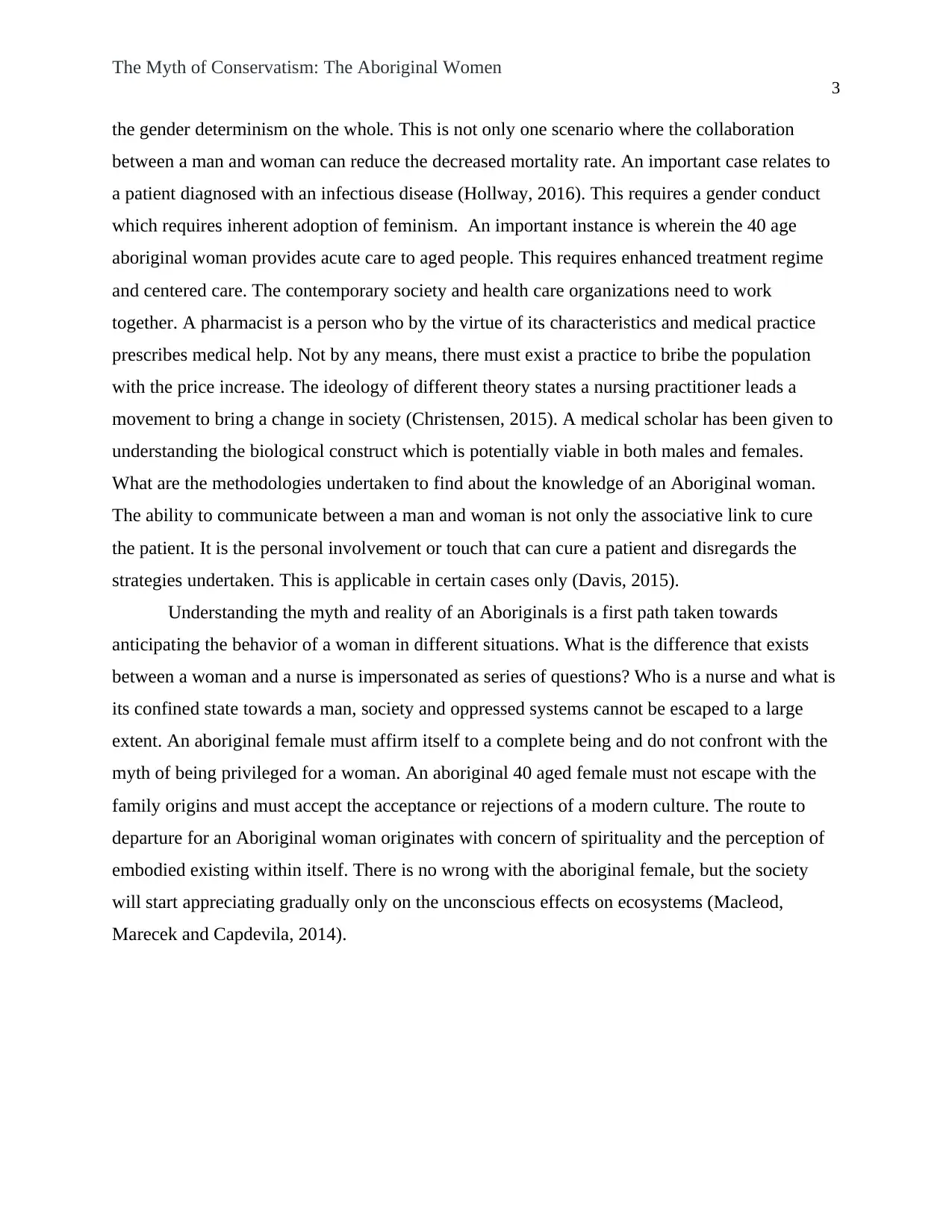
The Myth of Conservatism: The Aboriginal Women
3
the gender determinism on the whole. This is not only one scenario where the collaboration
between a man and woman can reduce the decreased mortality rate. An important case relates to
a patient diagnosed with an infectious disease (Hollway, 2016). This requires a gender conduct
which requires inherent adoption of feminism. An important instance is wherein the 40 age
aboriginal woman provides acute care to aged people. This requires enhanced treatment regime
and centered care. The contemporary society and health care organizations need to work
together. A pharmacist is a person who by the virtue of its characteristics and medical practice
prescribes medical help. Not by any means, there must exist a practice to bribe the population
with the price increase. The ideology of different theory states a nursing practitioner leads a
movement to bring a change in society (Christensen, 2015). A medical scholar has been given to
understanding the biological construct which is potentially viable in both males and females.
What are the methodologies undertaken to find about the knowledge of an Aboriginal woman.
The ability to communicate between a man and woman is not only the associative link to cure
the patient. It is the personal involvement or touch that can cure a patient and disregards the
strategies undertaken. This is applicable in certain cases only (Davis, 2015).
Understanding the myth and reality of an Aboriginals is a first path taken towards
anticipating the behavior of a woman in different situations. What is the difference that exists
between a woman and a nurse is impersonated as series of questions? Who is a nurse and what is
its confined state towards a man, society and oppressed systems cannot be escaped to a large
extent. An aboriginal female must affirm itself to a complete being and do not confront with the
myth of being privileged for a woman. An aboriginal 40 aged female must not escape with the
family origins and must accept the acceptance or rejections of a modern culture. The route to
departure for an Aboriginal woman originates with concern of spirituality and the perception of
embodied existing within itself. There is no wrong with the aboriginal female, but the society
will start appreciating gradually only on the unconscious effects on ecosystems (Macleod,
Marecek and Capdevila, 2014).
3
the gender determinism on the whole. This is not only one scenario where the collaboration
between a man and woman can reduce the decreased mortality rate. An important case relates to
a patient diagnosed with an infectious disease (Hollway, 2016). This requires a gender conduct
which requires inherent adoption of feminism. An important instance is wherein the 40 age
aboriginal woman provides acute care to aged people. This requires enhanced treatment regime
and centered care. The contemporary society and health care organizations need to work
together. A pharmacist is a person who by the virtue of its characteristics and medical practice
prescribes medical help. Not by any means, there must exist a practice to bribe the population
with the price increase. The ideology of different theory states a nursing practitioner leads a
movement to bring a change in society (Christensen, 2015). A medical scholar has been given to
understanding the biological construct which is potentially viable in both males and females.
What are the methodologies undertaken to find about the knowledge of an Aboriginal woman.
The ability to communicate between a man and woman is not only the associative link to cure
the patient. It is the personal involvement or touch that can cure a patient and disregards the
strategies undertaken. This is applicable in certain cases only (Davis, 2015).
Understanding the myth and reality of an Aboriginals is a first path taken towards
anticipating the behavior of a woman in different situations. What is the difference that exists
between a woman and a nurse is impersonated as series of questions? Who is a nurse and what is
its confined state towards a man, society and oppressed systems cannot be escaped to a large
extent. An aboriginal female must affirm itself to a complete being and do not confront with the
myth of being privileged for a woman. An aboriginal 40 aged female must not escape with the
family origins and must accept the acceptance or rejections of a modern culture. The route to
departure for an Aboriginal woman originates with concern of spirituality and the perception of
embodied existing within itself. There is no wrong with the aboriginal female, but the society
will start appreciating gradually only on the unconscious effects on ecosystems (Macleod,
Marecek and Capdevila, 2014).
Paraphrase This Document
Need a fresh take? Get an instant paraphrase of this document with our AI Paraphraser
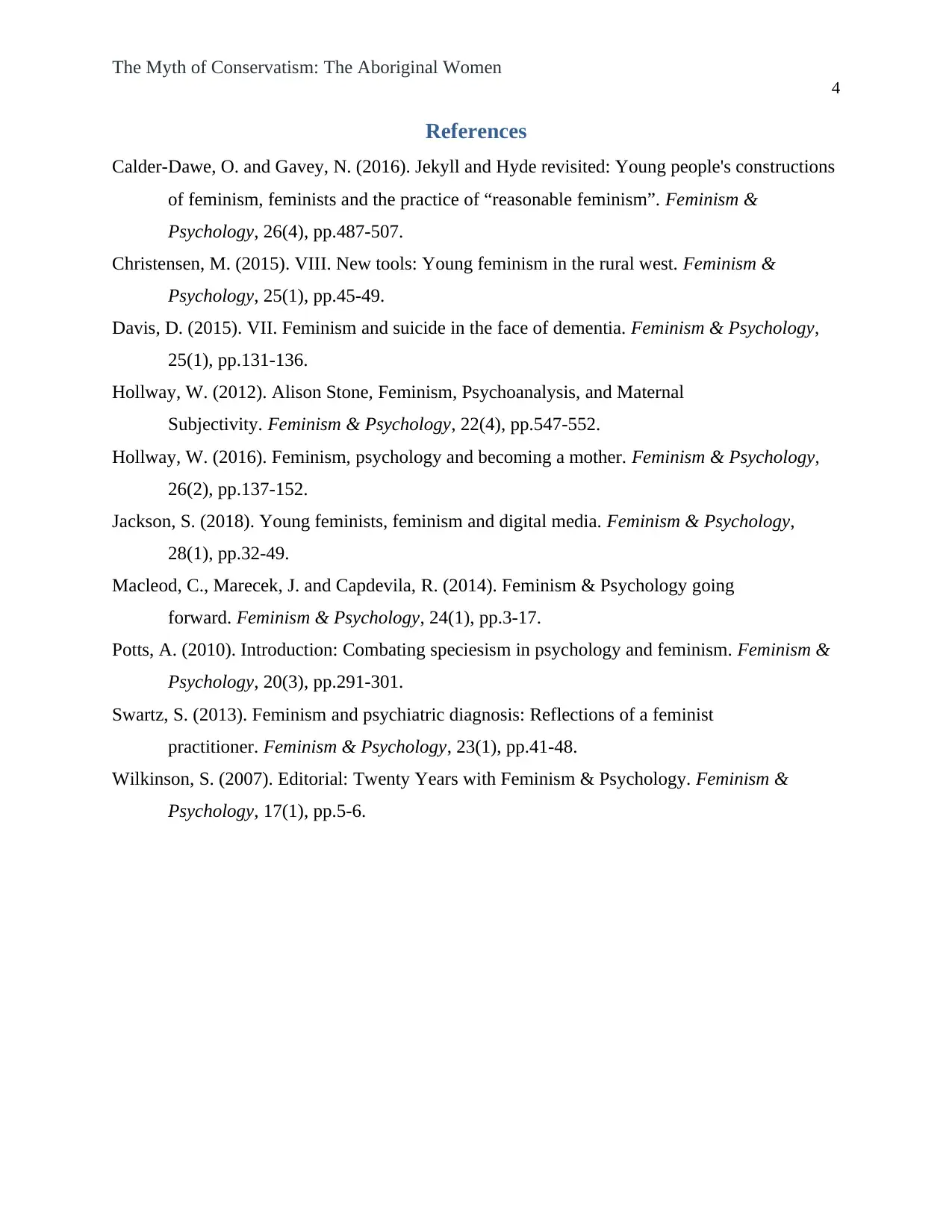
The Myth of Conservatism: The Aboriginal Women
4
References
Calder-Dawe, O. and Gavey, N. (2016). Jekyll and Hyde revisited: Young people's constructions
of feminism, feminists and the practice of “reasonable feminism”. Feminism &
Psychology, 26(4), pp.487-507.
Christensen, M. (2015). VIII. New tools: Young feminism in the rural west. Feminism &
Psychology, 25(1), pp.45-49.
Davis, D. (2015). VII. Feminism and suicide in the face of dementia. Feminism & Psychology,
25(1), pp.131-136.
Hollway, W. (2012). Alison Stone, Feminism, Psychoanalysis, and Maternal
Subjectivity. Feminism & Psychology, 22(4), pp.547-552.
Hollway, W. (2016). Feminism, psychology and becoming a mother. Feminism & Psychology,
26(2), pp.137-152.
Jackson, S. (2018). Young feminists, feminism and digital media. Feminism & Psychology,
28(1), pp.32-49.
Macleod, C., Marecek, J. and Capdevila, R. (2014). Feminism & Psychology going
forward. Feminism & Psychology, 24(1), pp.3-17.
Potts, A. (2010). Introduction: Combating speciesism in psychology and feminism. Feminism &
Psychology, 20(3), pp.291-301.
Swartz, S. (2013). Feminism and psychiatric diagnosis: Reflections of a feminist
practitioner. Feminism & Psychology, 23(1), pp.41-48.
Wilkinson, S. (2007). Editorial: Twenty Years with Feminism & Psychology. Feminism &
Psychology, 17(1), pp.5-6.
4
References
Calder-Dawe, O. and Gavey, N. (2016). Jekyll and Hyde revisited: Young people's constructions
of feminism, feminists and the practice of “reasonable feminism”. Feminism &
Psychology, 26(4), pp.487-507.
Christensen, M. (2015). VIII. New tools: Young feminism in the rural west. Feminism &
Psychology, 25(1), pp.45-49.
Davis, D. (2015). VII. Feminism and suicide in the face of dementia. Feminism & Psychology,
25(1), pp.131-136.
Hollway, W. (2012). Alison Stone, Feminism, Psychoanalysis, and Maternal
Subjectivity. Feminism & Psychology, 22(4), pp.547-552.
Hollway, W. (2016). Feminism, psychology and becoming a mother. Feminism & Psychology,
26(2), pp.137-152.
Jackson, S. (2018). Young feminists, feminism and digital media. Feminism & Psychology,
28(1), pp.32-49.
Macleod, C., Marecek, J. and Capdevila, R. (2014). Feminism & Psychology going
forward. Feminism & Psychology, 24(1), pp.3-17.
Potts, A. (2010). Introduction: Combating speciesism in psychology and feminism. Feminism &
Psychology, 20(3), pp.291-301.
Swartz, S. (2013). Feminism and psychiatric diagnosis: Reflections of a feminist
practitioner. Feminism & Psychology, 23(1), pp.41-48.
Wilkinson, S. (2007). Editorial: Twenty Years with Feminism & Psychology. Feminism &
Psychology, 17(1), pp.5-6.
1 out of 5
Your All-in-One AI-Powered Toolkit for Academic Success.
+13062052269
info@desklib.com
Available 24*7 on WhatsApp / Email
![[object Object]](/_next/static/media/star-bottom.7253800d.svg)
Unlock your academic potential
Copyright © 2020–2025 A2Z Services. All Rights Reserved. Developed and managed by ZUCOL.


